Curves
Attractors
..
I. Lorenz attractors – Strange attractor
– Pre/ intro: Code-oriented (sigsaly).
Main reference: Colin Sparow>
– Mathematical Elements for Computer Graphics – D. F. Rogers, J. A. Adams
– Attractor is generally named strange, when it has fractal structure.
– Edward Lorenz (et al) in 1963 made a model for atmospheric convection based on three ordinary differential eq. – known as Lorenz equations (Lorenz system – Wiki):
dx/dt = σ(y-x)
dy/dt = x*(ρ – z) – y
dz/dt = xz – βz
σ (Sigma, s) and ρ (Rho, r) and resp. B are system parameters constant. They r suppose to be positive and in Prandtl number ratio (Prandtl no – Wiki)
– Eqs were also used – and so not completely useless)) – in laser, dynamo techs, tectonic plates or speaking studies, or chemistry etc.
– they relates to 2D fluid layer of water uniformly warmed from bellow and cooled from above and so describe three changing qualities:
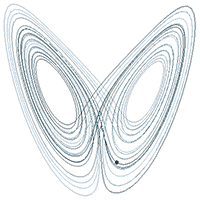
1) x – proportional convection rate.
2) y – horizontal temperature variation.
3) z – vertical temp. var.
Lorenz used the values σ = 10, β = 8/3 and ρ = 28 – for these (and nearby) values system in its knotted periodic orbits exhibits chaotic behavior and hence Chaotic attractor.
With ρ 99.96 it became T(3,2) torus knot.
Another common constants are a = 28, b = 46.92, c = 4. a is sometimes known as the Prandtl number and b as the Rayleigh number or {S=10, R=30, B=4} or {S=45, R=45, B=8/3}
In 1998 LA appeared as a 14th Smales´s problem (Smale’s problems – Wiki), which was in 2002 solved by Turke and simplified to 5 dimensional models – what a relief (I love when mathematicians want to simplify))..
The equations are non-linear – like most of physical ones (MATHEMATICA tutorial – Part 2.3: Non-linear Systems of ODEs (brown.edu)).
Butterfly effect
(MATHEMATICA TUTORIAL, Part 2.3: Lorenz Equations (brown.edu))
– ..
1972 Lorenz in his own work Predictability: Does the Flap of a Butterfly’s Wings in Brazil Set Off a Tornado in Texas? (4) coined the term BF as phenomenon that beside it looks like a butterfly it also have high sensitivity on initial conditions.
– Lorenz used 3decimal while previously using 6 decimals one (Rpic) – this less than one of a thousand difference made massive difference in result.

– in chaotic deterministic systems (resp. chaotic DS) – s chaotic is represented by the fact that already mention high initial sensitivity and fact that one cannot ever have infinitively exact (infinitive decimals) value and hence any state will eventually deviate – becoming unpredictable – chaotic.
– predictability horizon.
– 2.1 D – trajectories in one setting never repeats – see fractal structure.
– deterministic – because values are always calculatable to certain time range in predictability horizon very exactly.
– planet motion can be predicted to about 1 ml. y. and model estimating, that it has chaotic behavior in range of 4 ml y. – less then 10th of time from dinosaurs.
– dual pendulum have a L about 3 secs.
Lyapunov time
– LT hence Lambda (L, λ) resp L. exponent is t till also so know predictability horizon.
Fractal structure
– SA have fractal structure – even tough it has they are set in limited space range, their curves have infinite length – in its chaotic sets it never repeats itself because it has still smaller and smaller offsets.
Critical points and Saddle point
– Critical points – point of orbit
– Saddle point – df
LA in other forms
– LA as trefoil
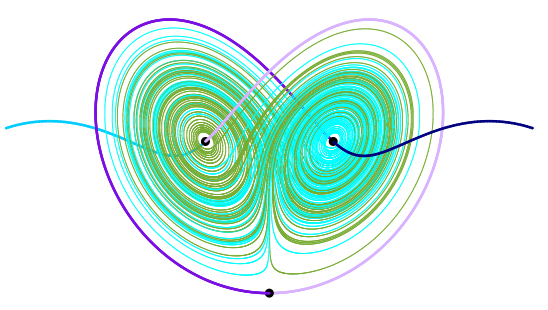
–
–
–
SA in Lua and Matlab
SA in Matlab
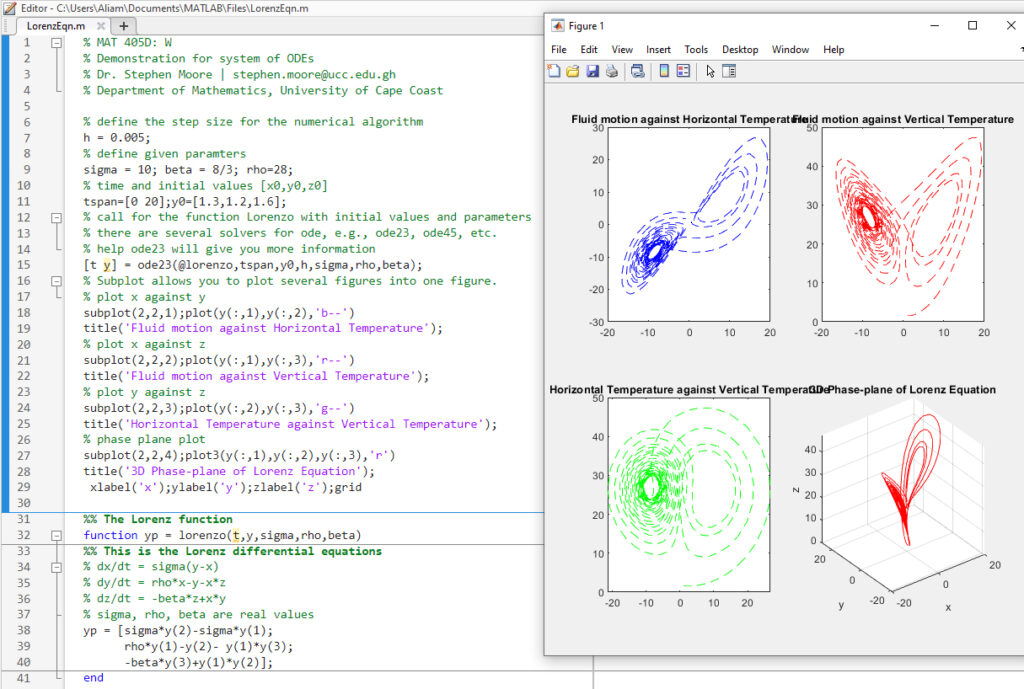
Line 7: define step length (smallest unit).
Line 9: defines σ (Sigma, s) and ρ (Rho, r) and resp. B constants.
Line 11: sets time and initial xyz points 1.3, 1.2, 1.6..
L32: define/ initialize fnct lorenzo
L28-30: Particular q.
–
LA in Lua
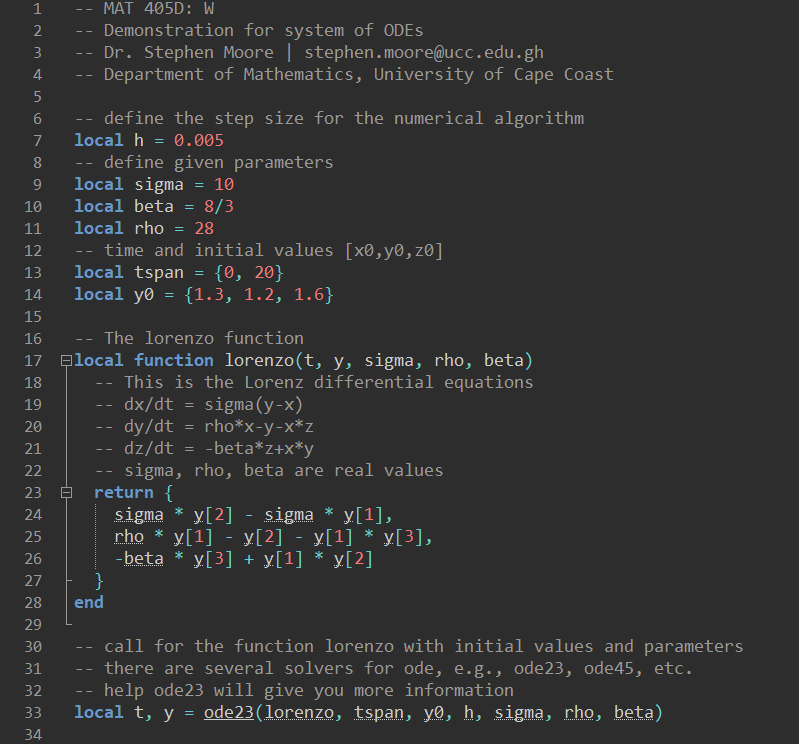
– line 33 actually define solvers – namely most common ode23…
–
LA in Mtlb’s Brain Dynamics Toolbox
Brain Dynamics Toolbox – open source in Matlab for DDS which typically appear in brain’s neuro waves – these waves are very similar like wavelets and electricity circuits.
..
–
LA in Architect
Here is look on LA made by AZZIN in Arch – Alberto Zin – Architect.
– since Arch is audiorate, this patch imo nicely demonstrates differences between audio-rate and typical patch environment using cca ms range. It is clear that some stuff are more straightforward and precise, while some are had to make done.. like typical dynamic clock w/ metro-float and +1.
– constants are in typical set up: σ = 10, β = 8/3 and ρ = 28
– Sigma is marked as “a” (for x), Rho as “r” (y) w/ 8/3 (2.66.) and B (z). (3 vertically white objects in upper left part)
– initial position values are 1,3, 1,2 and 1,6 – the values are closed together so in typical constants one can expect butterfly fx. (3 horizontally white objects in upper part)
Dt 0,005 is probably step size – smallest unit. (object marked as dt)
Memory, store and load are for value triggering, which order is surprisingly define by order module (unlike in Pd, triggers are going from left to right): so first load goes z, y, x initial values, and then trigger goes x, y, z for multiplying constants and then delta-time (Dt).
“x” and “-” are regular math operator * and -.
Init, a, b, r, step are inlets and X, Y, Z bottom modules (not fully seen) outlets.
– according to documentation, INIT values are already initialized and step is recommended in typical set up for metronome (clock – can be 1ms in Pd).
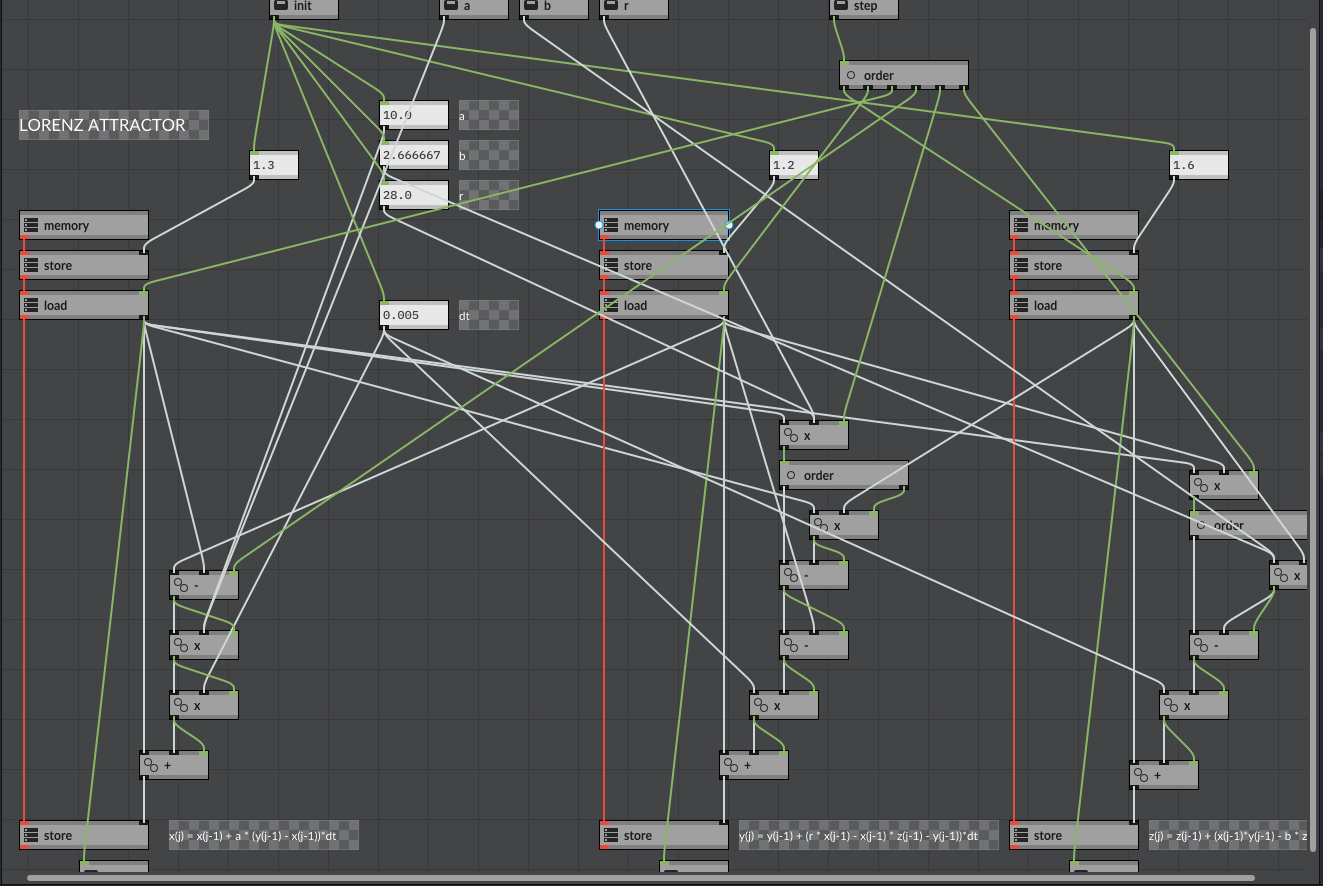
Eqs got probably multiplied by dt to move it to left side of equation.
Why is x(j) = x(j-1) + a * (y(j-1) – x(j-1)*dt ?
I ve already got, that j stands for sample buffer – then bold x(j-1) in x(j) = x(j-1) + a * (y(j-1) – x(j-1)*dt – so x = x in one unit of metronome back (written as j-1) + its rate of change define as: a * (y (j-1) – x(j-1)) * dt – but still not see thru it..
LA in M4L
Devices
Strange Mod
– ytb: Bastan.
– all modulation is based on Attractors.
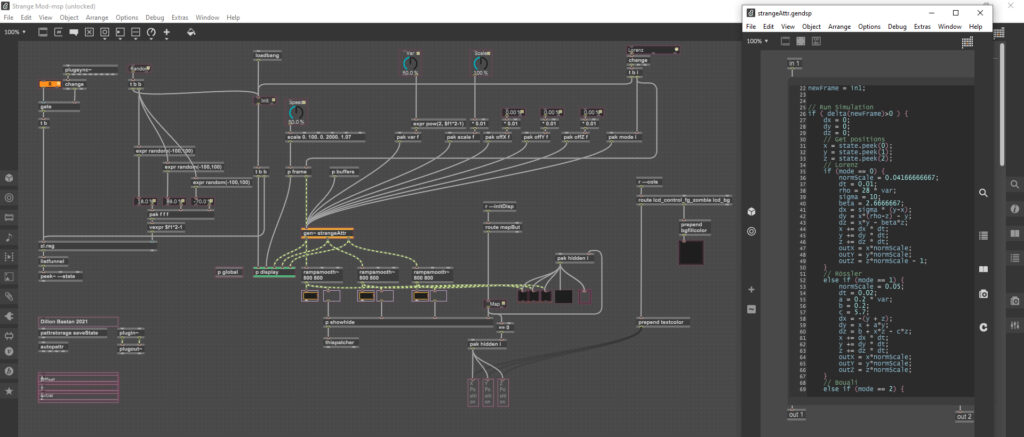
Yellow subpatch is Codebox w/ Cbased Attractor code.
LA in Pd
Intro
– Q2 2024: LA is now newly in GEM so it should now be possible to do in Plugdata and there is also here is Lorenz module in ELSE lib and example of Lorenz is in Expr~ …
– unlike the previous examples, this one was trying to do it in typical non-audio (cca 1ms) rate..
X
–
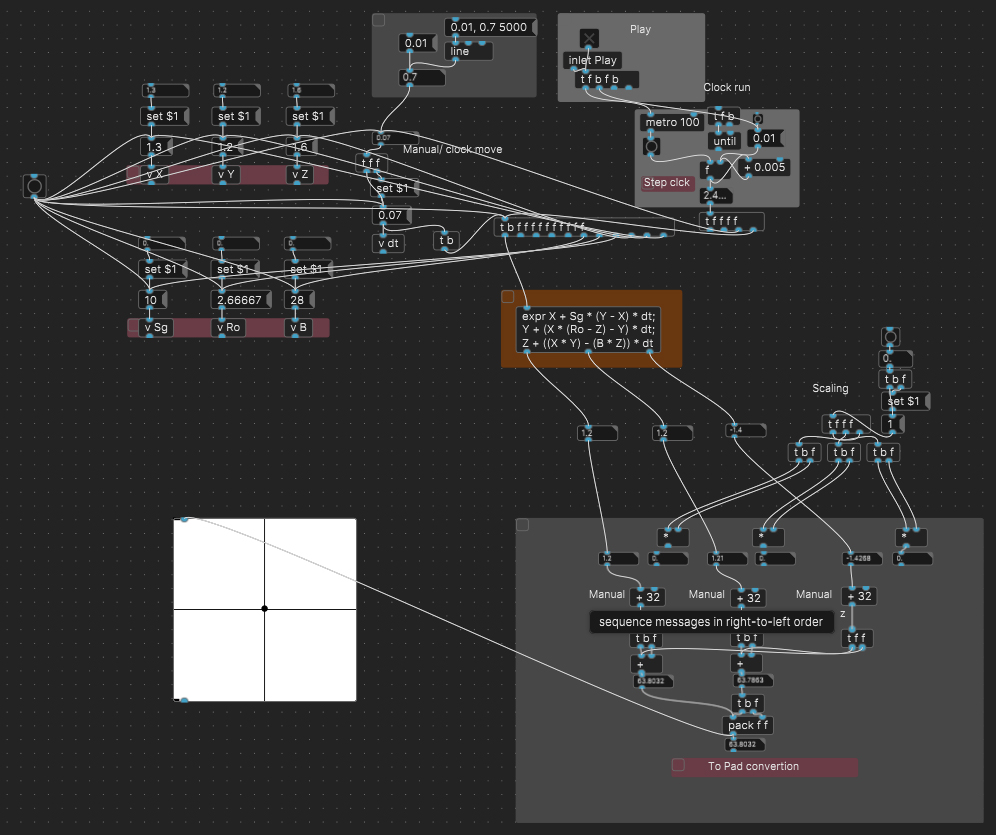
–
–
–
Apendix
Sources
1) Chaos Theory: the language of (in)stability (Gonkee – ytb)
–
Chaos: The Science of the Butterfly Effect (youtube.com)
–
3) Lorenz Attractor and Chaos (MIT – ytb)
–
4) 132_kap6_lorenz_artikel_the_butterfly_effect.pdf (gymportalen.dk) – Lorenz, E. 1972 Predictability: Does the Flap of a Butterfly’s Wings in Brazil Set Off a Tornado in Texas? (1972)
II. Lorenz Strange attractor in double pendulum
IIIa. Strange Thomas attractor
Intro
– as already said, strange at. are us
Attraktoren (3d-meier.de) – particularly Thomas Attractor.
Download patch: Strange_Attractors at main | GitHub
Setting up particle syst.
2’ Jit.world Attractive (name-argument)
6’ Jit.gl.mesh Attractive @draw_mode points @color 1. 1. 1. 1. – white (@ – attributes)
7’ Jit.noise 3 – 3 means three planes 2500 – num. of particles.
– randomization will be in only top-right positive quadrant. Fix it can: jit.map @map 0. 1. -1. 1 (nums rescale to bipolar range.)
jit.gl.camera attractivee @lookat 0. 0. 0. @locklook 1 – 1.at. – look at center, 2.at. – keep center look.
jit.anim.drive @ui_listen 1 – connecting it to camera, applies it direction change
– connecting j-anim to j-cam and clock on its window – u will be able to look LR w/ a-d letter on kyb and WS will move back and forth
– anim_reset, reset change of look
Explaining the formula and FB
–
Implementing the formula
–
IIIb. Chaotic sounds – Hearing Glass | Umut Eldem
Gen~ and FB
– in previous two chapters Umut is continuing to explore further Thomas At.
– this time history operator is used.
Implementing the formula
–
IV. Jit
Jit.gl
Max tutorial: intro to jit.gl.material (youtube.com)
Jit.pwindow name
Jit.gl render name
Check also: jit.gl.node, jit.gl.cornepin
See also jit.gl.mesh bellow, related more to jit.gen tough..
Jit.lua
Max tutorial: intro to jit.gl.material (youtube.com)
– jit.lua is used in Dillon’s Strange mod device..
Jit.anim.drive
Max tutorial: intro to jit.gl.material (youtube.com)
– is used w/ jit.lua in Attractor.
Jit.gen
Jit.matrix
jit.matrix Reference – Max 8 Documentation (cycling74.com)
– it is related to Jit.gen
Jit.gl.mesh
jit.gl.mesh Reference – Max 8 Documentation (cycling74.com)
– it is related to Jit.gen.
– can also expect jit.matrix data.
Jit.world
Max tutorial: intro to jit.gl.material (youtube.com)
related to jit.gl object – allowing
– it automatically creates graphic-win, turn on w/ Toogle etc (in Rinlet).
– 2nd outlet can display jit.fpsgui – obviously frame per second display.